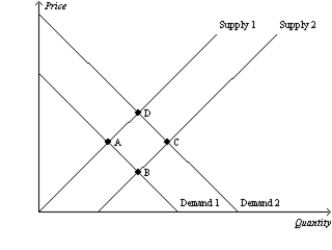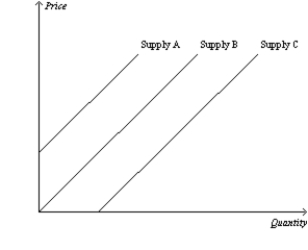A) the relationship between price and the number of buyers in a market.
B) how quantity demanded changes when the number of sellers changes.
C) the sum of all prices that individual buyers are willing and able to pay for each possible quantity of the good.
D) how much of a good all buyers are willing and able to buy at each possible price.
Correct Answer

verified
Correct Answer
verified
Multiple Choice
If the price of a good is low,
A) firms would increase profit by increasing output.
B) the quantity supplied of the good could be zero.
C) the supply curve for the good will shift to the left.
D) firms can and should raise the price of the product.
Correct Answer

verified
Correct Answer
verified
True/False
A market is a group of buyers and sellers of a particular good or service.
Correct Answer

verified
Correct Answer
verified
Multiple Choice
Equilibrium price must decrease when demand
A) increases and supply does not change, when demand does not change and supply decreases, and when demand decreases and supply increases simultaneously.
B) increases and supply does not change, when demand does not change and supply decreases, and when demand increases and supply decreases simultaneously.
C) decreases and supply does not change, when demand does not change and supply increases, and when demand decreases and supply increases simultaneously.
D) decreases and supply does not change, when demand does not change and supply increases, and when demand increases and supply decreases simultaneously.
Correct Answer

verified
Correct Answer
verified
Multiple Choice
Table 4-7
 -Refer to Table 4-7. If these are the only four sellers in the market for ice cream, then when the price increases from $4 to $6, the market quantity supplied
-Refer to Table 4-7. If these are the only four sellers in the market for ice cream, then when the price increases from $4 to $6, the market quantity supplied
A) decreases by 10 gallons.
B) decreases by 20 gallons.
C) increases by 10 gallons.
D) increases by 20 gallons.
Correct Answer

verified
Correct Answer
verified
Multiple Choice
Suppose you like to make, from scratch, pies filled with banana cream and vanilla pudding. You notice that the price of bananas has increased. As a result, your demand for vanilla pudding would
A) decrease.
B) increase.
C) be unaffected.
D) There is insufficient information given to answer the question.
Correct Answer

verified
Correct Answer
verified
Multiple Choice
Figure 4-26  -Refer to Figure 4-26. Which of the following movements would illustrate the effect in the market for fences of a decrease in the price of wood?
-Refer to Figure 4-26. Which of the following movements would illustrate the effect in the market for fences of a decrease in the price of wood?
A) Point A to Point B
B) Point C to Point B
C) Point C to Point D
D) Point A to Point D
Correct Answer

verified
Correct Answer
verified
Multiple Choice
When a surplus exists in a market, sellers
A) raise price, which increases quantity demanded and decreases quantity supplied, until the surplus is eliminated.
B) raise price, which decreases quantity demanded and increases quantity supplied, until the surplus is eliminated.
C) lower price, which increases quantity demanded and decreases quantity supplied, until the surplus is eliminated.
D) lower price, which decreases quantity demanded and increases quantity supplied, until the surplus is eliminated.
Correct Answer

verified
Correct Answer
verified
Multiple Choice
A very hot summer in Atlanta will cause
A) the demand curve for lemonade to shift to the left.
B) the demand for air conditioners to decrease.
C) the demand for jackets to decrease.
D) a movement downward and to the right along the demand curve for tank tops.
Correct Answer

verified
Correct Answer
verified
Multiple Choice
The market demand curve
A) is found by vertically adding the individual demand curves.
B) slopes upward.
C) represents the sum of the prices that all the buyers are willing to pay for a given quantity of the good.
D) represents the sum of the quantities demanded by all the buyers at each price of the good.
Correct Answer

verified
Correct Answer
verified
True/False
Whenever a determinant of supply other than price changes, the supply curve shifts.
Correct Answer

verified
Correct Answer
verified
Multiple Choice
An example of a perfectly competitive market would be the market for
A) tennis racquets.
B) pizza.
C) garbage collection.
D) wheat.
Correct Answer

verified
Correct Answer
verified
Multiple Choice
When supply and demand both increase, equilibrium
A) price will increase.
B) price will decrease.
C) quantity may increase, decrease, or remain unchanged.
D) price may increase, decrease, or remain unchanged.
Correct Answer

verified
Correct Answer
verified
Multiple Choice
Soup is an inferior good if the demand
A) for soup falls when the price of a substitute for soup rises.
B) for soup rises when the price of soup falls.
C) curve for soup slopes upward.
D) for soup falls when income rises.
Correct Answer

verified
Correct Answer
verified
Multiple Choice
Table 4-2
 -Refer to Table 4-2. Whose demand does not obey the law of demand?
-Refer to Table 4-2. Whose demand does not obey the law of demand?
A) Abby's
B) Brandi's
C) Carrie's
D) DeeDee's
Correct Answer

verified
Correct Answer
verified
Multiple Choice
The two words economists use most often are
A) inflation and trade.
B) supply and demand.
C) competition and prices.
D) markets and equilibrium.
Correct Answer

verified
Correct Answer
verified
Multiple Choice
Figure 4-26  -Refer to Figure 4-26. Which of the following movements would illustrate the effect in the market for golf balls of an increase in green fees?
-Refer to Figure 4-26. Which of the following movements would illustrate the effect in the market for golf balls of an increase in green fees?
A) Point A to Point B
B) Point C to Point B
C) Point C to Point D
D) Point A to Point D
Correct Answer

verified
Correct Answer
verified
Multiple Choice
The supply curve for stand up paddle boards
A) shifts when the price of stand up paddle boards changes because the price of stand up paddle boards is measured on the vertical axis of the graph.
B) shifts when the price of stand up paddle boards changes because the quantity supplied of stand up paddle boards is measured on the horizontal axis of the graph.
C) does not shift when the price of stand up paddle boards changes because the price of stand up paddle boards is measured on the vertical axis of the graph.
D) does not shift when the price of stand up paddle boards changes because the price of stand up paddle boards is measured on the horizontal axis of the graph.
Correct Answer

verified
Correct Answer
verified
Multiple Choice
Figure 4-15  -Refer to Figure 4-15. Which of the following would cause the supply curve to shift from Supply B to Supply A in the market for beer?
-Refer to Figure 4-15. Which of the following would cause the supply curve to shift from Supply B to Supply A in the market for beer?
A) a decrease in the price of beer
B) an expectation by firms that the price of beer will increase in the very near future
C) a decrease in the price of hops
D) an improvement in technology that allows firms to use less labor in the production of beer
Correct Answer

verified
Correct Answer
verified
True/False
When quantity supplied exceeds quantity demanded at the current market price, the market has a surplus, and market price will likely rise in the future to eliminate the surplus.
Correct Answer

verified
Correct Answer
verified
Showing 201 - 220 of 700
Related Exams